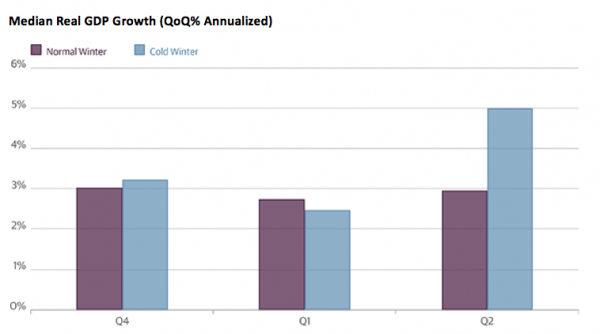When Bill Clinton beat George H.W. Bush in the 1992 presidential election, campaign strategist James Carville’s now-famous explanation was, “It’s the economy, stupid!” To paraphrase a more polite version of Carville, I believe the punch line to why real first-quarter gross domestic product (GDP) growth will thwart the consensus forecast of 1.4 percent is just as simple: “It’s the weather…!”
Severe weather conditions this winter have had a profound impact on economic activity in the United States. Based on our analysis of retail sales, industrial production, and government spending, I wouldn’t be surprised to see U.S. economic growth near zero or even negative in the first quarter. This out-of-consensus position is supported by the Federal Reserve Bank of Atlanta, which recently forecast 0.1 percent growth.
When you look at the data, the winter ravages in first quarter are clear. Consumer spending declined in December and January, and was basically flat in February, while nonfarm payrolls were up by just 126,000 in March—the smallest gain since December 2013. As a result of the harsh March weather, 216,000 people reported being unable to work, and over 560,000 people were forced to work part time. Retail data have also borne out the consumer’s frigidness this winter. In February, U.S. retail sales declined 0.2 percent, adding to declines in January and December, and making it the worst three-month performance for retail sales since 2009. Other hard-hit sectors of the economy include construction, where spending declined in both January and February, and manufacturing, with the March Institute for Supply Management (ISM) reading worse than the lows seen last winter.
Essentially, it appears we are having a replay of what happened in the first quarter of 2014, where winter weather distortions caused the economy to slow dramatically. This winter, the warning signs are even stronger, but there seems to be some cognitive dissonance among economists. A Bloomberg survey pegs consensus GDP estimates at 1.4 percent, for example. Besides the Atlanta Fed, I have not seen many forecasts approach zero. All this leads me to believe the market may not be anticipating the full impact of weather distortions on the U.S. economy. Investors’ shock at the true state of first-quarter GDP could easily send interest rates back to test the lows of January, or maybe even lower.
Rather than hit the panic button, investors should view a disappointing first-quarter GDP print as a short-term dislocation. Since 1975, a slowdown in first-quarter growth caused by winter weather has usually been followed by a significant bounce back in the second quarter. The underlying strength of the U.S. economy remains sound, so I expect a similar pattern will play out in the remainder of 2015. While noise around the economy could lead to increased volatility in equities and credit spreads, the bottom line is that weather-induced weakness may present long-term investors with an opportunity to increase their positions to risk assets at discounted prices.
Winter Slowdown Should Lead to Q2 Bounce Back
Cold weather has chilled economic activity in the first quarter, with the Atlanta Fed’s GDP tracking estimate now showing growth is essentially zero. While such a low print on GDP would likely cause financial market turbulence, the slowdown is likely to prove short-lived. Since 1975, a slow first quarter caused by winter weather has usually been followed by a large bounce back in growth in the second quarter, often exceeding the growth rate seen in the fourth quarter prior to the slowdown.

Source: Bloomberg, Haver, Guggenheim Investments. Data as of 4/7/2015. *Note: Cold winters are defined as Q1 population weighted average temperature more than 1 degree colder than average. There have been 13 such winters since 1975.
--
This material is distributed for informational purposes only and should not be considered as investing advice or a recommendation of any particular security, strategy or investment product. This article contains opinions of the author but not necessarily those of Guggenheim Partners or its subsidiaries. The author’s opinions are subject to change without notice. Forward looking statements, estimates, and certain information contained herein are based upon proprietary and non-proprietary research and other sources. Information contained herein has been obtained from sources believed to be reliable, but are not assured as to accuracy. No part of this article may be reproduced in any form, or referred to in any other publication, without express written permission of Guggenheim Partners, LLC. ©2015, Guggenheim Partners. Past performance is not indicative of future results. There is neither representation nor warranty as to the current accuracy of, nor liability for, decisions based on such information. Past performance is not indicative of future results. There is neither representation nor warranty as to the current accuracy of, nor liability for, decisions based on such information.
Scott Minerd is Chairman of Investments and Global Chief Investment Officer at Guggenheim Partners

